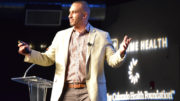DENVER, Colo. – Last Tuesday, Prime Health and TechrIoT convened a panel of experts to discuss the opportunities and barriers for connected devices and data in the healthcare industry. Kit Hughes moderated the panel, which included Nim Patel, co-founder of EngageMyHealth and nimbleIQ; Steve Adams, CEO of LEO Technologies; and Dr. Kenneth Bellian, co-founder of AI Health.
According to a recent paper in Healthcare Informatics Research, health-related technology will account for 40% of IoT technology by 2020, making up a $117 billion market. While investors continue to drive entrepreneurial innovation in the world of connected things, healthcare executives are trying to understand what the future of care will look like and how to take advantage of the vast amount of data available.
“From a hospital executive perspective, IT has always been a cost center,” said Dr. Bellian. “We need to change this and start thinking in terms of ROI.”
Demand for better quality and lower cost care has forced industry leaders to increase transparency and use technology to improve access to health services. Companies like CirrusMD and EMS Relay have found success by helping health systems take advantage of technology to meet these goals; however, there is still great need for disruption within the fragmented health system.
“Solutions will come from people who are nudging the healthcare system to think differently,” Dr. Bellian added, referring to a range of recent innovations, from smart home technologies that drive better senior care to accelerometer technologies that diagnose depression.
In the push and pull relationship between innovators and industry incumbents, Steve Adams stressed the importance of robust, repeatable, and reliable outcomes data and the absolute importance of cyber security for devices that hold the potential to hurt patients.
“Regulators are taking note of events like the cyber attacks in October,” said Adams, “and we need to take extraordinary care to ensure that products are developed with the Hippocratic oath in mind.”
The smallest variations in data for these connected devices can cause serious consequences for providers and patients, and health administrators are founded in their hesitations to adopt unproven technologies, particularly in the case of medical devices, where regulations and reimbursements are obviously more strenuous than those for fitness wearables. Panelists suggested using a variety of data sources to drive meaningful insights about behavior change and human physiology.
In response to the chasm between opportunity and evidence-base, Patel suggested that consumers and patient advocates hold the key to unlocking potential.
“We are not going to see meaningful change,” Patel explained, “until consumers come out en masse and say, ‘this data is not the healthcare system’s; it doesn’t belong to an individual provider – this is my data.”
Like the coverage that CyberMed News provides? Follow us on Twitter, LinkedIn, and Facebook to keep up-to-date on the latest developments in digital health.






Be the first to comment on "Exploring the Role of IoT in Healthcare"